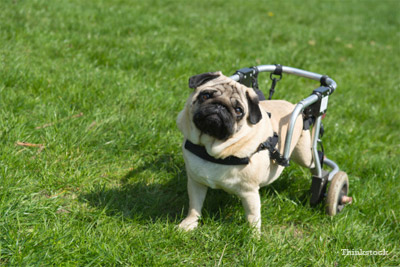
Kelly Serfas, a Certified Veterinary Technician in Bethlehem, PA, contributed to this article.
Most paralyzed dogs (a.k.a. “down dogs”) have a condition affecting the spine. Others with decreased mobility include dogs who were hit by a car or with metabolic disturbances, brain conditions and severe diseases. Being unable to move or reposition can affect multiple organs. Here are some tips to help paralyzed dogs stay more comfortable:
1. Set up a small area with plenty of comfortable, clean, dry and thick padding
Not only do you want your pet to be comfortable, but also protected from damage to the skin or “bed sores.” Change the bedding when necessary to keep it dry and clean. Ideally, the area you choose would be close to where you spend most of your time. This can be a crate, a play pen or a blocked off area. You will be able to keep a close eye on your dog, and your dog will feel included in the “pack.”
2. Change your dog’s position every 4 to 6 hours, if he is unable to move spontaneously
After lying on one side for an extended period of time, damage from pressure or poor circulation can happen to the skin, tissues, the lungs and many other organs.
3. Carry or sling your dog to go outside
Encouraging controlled movement is good for circulation, muscle tone and doggy psychology. Massage and simple physical therapy exercises also help with circulation. In some specific cases, dogs can be equipped with a cart to help with their mobility and spirits. This is an important discussion you need to have with your veterinarian.
4. Help your dog with healthy bathroom habits
If your dog is unable to urinate on his own, your vet will either send him home with a urinary catheter, or show you how to manually “express” (empty) the bladder. A catheter should have a sterile collection system which typically consists of an IV line and a fluid bag where the urine collects.
Keep the bag and the line as clean as possible by wiping them daily with a mild cleaner to keep infection from entering the body. Monitor the entrance site of the urinary catheter.
If you notice redness, discharge or swelling, please call your family veterinarian or your surgeon right away. During manual expression, you need to apply gentle, steady pressure on the lower belly until the bladder is empty. Always keep your pet clean and dry. Urine and stool are irritating to the skin, and can cause skin irritation or infection.
Defecation typically happens spontaneously, as long as your dog eats enough. Otherwise, ask your vet for a safe laxative.
5. Whether your dog can eat on his own or you need to help, make sure he is sitting upright at all times
Otherwise, there is a risk of “aspirating,” which means that food goes down the "wrong pipe." Food may then enter the lungs and cause pneumonia (aspiration pneumonia). Giving oral medications also requires your pet to be sitting up.
6. Last, but not least, provide plenty of TLC
Being paralyzed is stressful to your pet. Spend as much time together as possible. Watch TV, read a book or type emails next to your dog; he will be happy to be close to you.
Having a paralyzed dog is a tough situation and a big commitment. By following these tips, you should be able to avoid most of the common complications from prolonged paralysis and help your dog be comfortable and happy.
If you have any questions or concerns, you should always visit or call your veterinarian -- they are your best resource to ensure the health and well-being of your pets.
